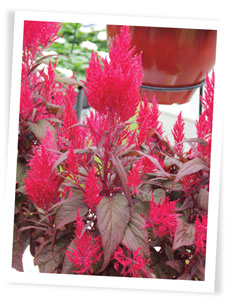8/27/2015
Fanning the Flames
Katie Elzer-Peters

Dragon’s Breath Celosia could be named for its giant, flame-red flower plumes that look just like a sharp exhale of a fire-breathing dragon. Or it could be named for the less-than-ideal conditions in which it thrives.
“This is one of the few plants that actually keeps looking better and better after leaving the garden center and going home with the consumer,” says Brad Smith, Retail Category Manager for Sakata. All plants grow, but these plants develop deeper color in the leaves and bigger flowers with less care. “They’re great for homeowners who tend to underfertilize and underwater things. Especially for people who go out of town and forget to hire a plant sitter. They can go a day or two without water.”
If, when you think “celosia,” you think “small six packs,” you’re in for a huge surprise with Dragon’s Breath. This plant is a monster—perhaps another source of the name. A single plant can stand waist-high in a pot and is produced in a gallon-sized pot—at the smallest.
“They grow one to a pot in a gallon. And that’s the smallest container I’d grow them in. You could grow them in a 3-gal. pot,” said Jim Stepp, Production Manager at Van Wingerden International, who grew the trial plants of this variety in 2014. “It’s a really outstanding variety with the big plumy flowers and dark red foliage.”
Because they’re short-day plants (in terms of blooming) in the summer, they may revert to foliage, blooming again in the fall. But “the foliage is so attractive, they’re still beautiful in the landscape,” Jim says. He cautions growers to pay attention to cultural requirements. “Grow these a little hungry—too much fertilizer and the leaves turn green instead of burgundy.”
Dragon’s Breath stole the show at the Sakata Spring Trials location. “By the second day, we had people coming in the door of our display saying ‘Where is it? Where is this new celosia?’” Brad says.
“They’re true stand-alone plants,” adds Jim. Many plants in this category—larger, showy, focal point annuals—are vegetatively propagated, while Dragon’s Breath is seed-grown. (Seeds are available from any seed broker.)
“It’s a bit of an oddity in the category,” says Brad. “A seed-grown plant being grown and marketed as such a large specimen.” This makes the plant attractive, in terms of costs. The cost of seeds for a premium annual, while still more than smaller varieties, is less than material for vegetatively propagated plants.
Plants will hit the consumer market in 2016. Sakata is offering a branded pot for growers and retailers. “They don’t have to use the pot, but doing so is like having another salesperson on the floor. It basically does your job for you.”
If you want something large and showy to plant outside your garden center to drive customer traffic in 2016, this plant looks to be a good choice. Low maintenance, requiring little-to-no fertilizer, drought-tolerant and with a big, bossy stage presence, it’s the perfect candidate to flank your roadside garden center sign. GP
Katie Elzer-Peters is a garden writer and owner of The Garden of Words, LLC, a marketing and PR firm handing mostly green-industry clients. Contact her at Katie@thegardenofwords.com or at www.thegardenofwords.com.